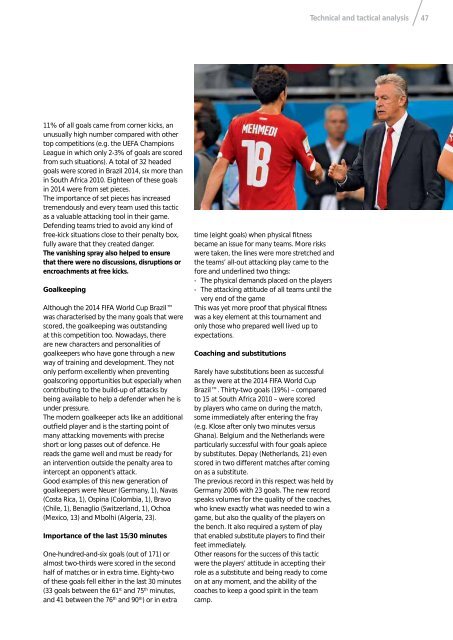You also want an ePaper? Increase the reach of your titles
YUMPU automatically turns print PDFs into web optimized ePapers that Google loves.
Technical and tactical analysis 4711% of all goals came from corner kicks, anunusually high number compared with othertop competitions (e.g. the UEFA ChampionsLeague in which only 2-3% of goals are scoredfrom such situations). A total of 32 headedgoals were scored in Brazil 2014, six more thanin South Africa 2010. Eighteen of these goalsin 2014 were from set pieces.The importance of set pieces has increasedtremendously and every team used this tacticas a valuable attacking tool in their game.Defending teams tried to avoid any kind offree-kick situations close to their penalty box,fully aware that they created danger.The vanishing spray also helped to ensurethat there were no discussions, disruptions orencroachments at free kicks.GoalkeepingAlthough the 2014 FIFA World Cup Brazilwas characterised by the many goals that werescored, the goalkeeping was outstandingat this competition too. Nowadays, thereare new characters and personalities ofgoalkeepers who have gone through a newway of training and development. They notonly perform excellently when preventinggoalscoring opportunities but especially whencontributing to the build-up of attacks bybeing available to help a defender when he isunder pressure.The modern goalkeeper acts like an additionaloutfield player and is the starting point ofmany attacking movements with preciseshort or long passes out of defence. Hereads the game well and must be ready foran intervention outside the penalty area tointercept an opponent’s attack.Good examples of this new generation ofgoalkeepers were Neuer (Germany, 1), Navas(Costa Rica, 1), Ospina (Colombia, 1), Bravo(Chile, 1), Benaglio (Switzerland, 1), Ochoa(Mexico, 13) and Mbolhi (Algeria, 23).Importance of the last 15/30 minutesOne-hundred-and-six goals (out of 171) oralmost two-thirds were scored in the secondhalf of matches or in extra time. Eighty-twoof these goals fell either in the last 30 minutes(33 goals between the 61 st and 75 th minutes,and 41 between the 76 th and 90 th ) or in extratime (eight goals) when physical fitnessbecame an issue for many teams. More riskswere taken, the lines were more stretched andthe teams’ all-out attacking play came to thefore and underlined two things:- The physical demands placed on the players- The attacking attitude of all teams until thevery end of the gameThis was yet more proof that physical fitnesswas a key element at this tournament andonly those who prepared well lived up toexpectations.Coaching and substitutionsRarely have substitutions been as successfulas they were at the 2014 FIFA World CupBrazil. Thirty-two goals (19%) – comparedto 15 at South Africa 2010 – were scoredby players who came on during the match,some immediately after entering the fray(e.g. Klose after only two minutes versusGhana). Belgium and the Netherlands wereparticularly successful with four goals apieceby substitutes. Depay (Netherlands, 21) evenscored in two different matches after comingon as a substitute.The previous record in this respect was held byGermany 2006 with 23 goals. The new recordspeaks volumes for the quality of the coaches,who knew exactly what was needed to win agame, but also the quality of the players onthe bench. It also required a system of playthat enabled substitute players to find theirfeet immediately.Other reasons for the success of this tacticwere the players’ attitude in accepting theirrole as a substitute and being ready to comeon at any moment, and the ability of thecoaches to keep a good spirit in the teamcamp.


